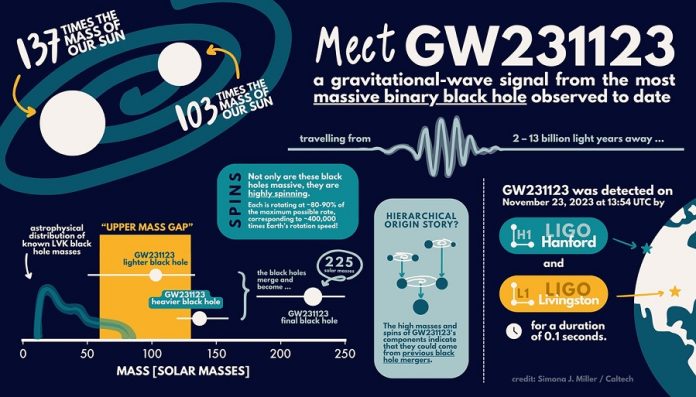
In an incredible leap forward for astronomy, scientists have detected the most massive black hole merger ever observed through gravitational waves.
The event, named GW231123, occurred on November 23, 2023, and was picked up by the LIGO observatories in the United States, part of a global network of detectors that includes Virgo in Italy and KAGRA in Japan.
The powerful collision resulted in a single black hole that is around 225 times the mass of our Sun—making it by far the heaviest black hole merger ever detected.
For comparison, the first black hole merger ever observed by LIGO in 2015 produced a final black hole with just 62 solar masses.
This new discovery was made during the fourth observing run of the LIGO-Virgo-KAGRA (LVK) Collaboration, a group of scientists using ultra-sensitive instruments to detect tiny ripples in space-time called gravitational waves. These waves are created when massive objects like black holes crash into one another.
In the GW231123 event, two huge black holes—about 100 and 140 times the mass of the Sun—combined into one. Not only were these black holes incredibly massive, but they were also spinning at extreme speeds, close to the theoretical maximum predicted by Einstein’s theory of general relativity.
Such large, fast-spinning black holes are hard to explain using current models of how black holes form. According to Mark Hannam of Cardiff University, black holes this massive shouldn’t exist if we follow the typical path of stellar evolution. One theory is that these black holes were already the result of previous mergers, forming a kind of “second-generation” pair.
To study this merger, scientists had to use advanced models that account for how fast-spinning black holes behave—a complicated challenge. Charlie Hoy of the University of Portsmouth noted that the high spin made the gravitational-wave signal hard to interpret, pushing current scientific tools to their limits.
Despite these difficulties, the event offers an exciting opportunity for researchers. Gregorio Carullo of the University of Birmingham says it could take years to fully understand what this cosmic collision reveals, and more complex possibilities beyond a basic black hole merger may eventually come into focus.
Gravitational-wave detectors like LIGO are helping scientists explore extreme cosmic events that were once invisible. Sophie Bini from Caltech says this discovery shows just how much gravitational-wave astronomy is advancing and hints at the many secrets the universe still holds.
More details about GW231123 will be shared at a major international conference in Glasgow in July 2025. The data will also be made public, allowing researchers around the world to dig deeper into this record-breaking cosmic collision.
Source: Caltech.



